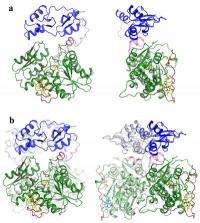This protein structure shows two views of the CBS protein that's involved in production of hydrogen sulfide for cell signaling. In A), the individual protein is shown; in B) two CBS proteins are shown bound in a "dimer" formation found in nature. Credit: Banerjee/Smith, University of Michigan
University of Michigan researchers have solved the structure of a protein that is integral to processes responsible for maintaining a healthy heart and nervous system.
The protein structure in question is cystathionine beta-synthase, known as CBS. CBS uses vitamin B6 to make hydrogen sulfide (H2S), a gaseous signaling molecule that helps maintain a healthy heart and nervous system. H2S also induces a state of suspended animation or hibernation in animals by decreasing body temperature and lowering metabolic rate.
The work to decode the structure was led by Ruma Banerjee, Ph.D., a professor in the Department of Biological Chemistry at the U-M Medical Schoool, Janet Smith, Ph.D., a research professor at the U-M Life Sciences Institute, and their colleagues. Their findings are published today in the Proceedings of the National Academy of Sciences.
"The structure of full-length CBS, which has eluded the science community for more than a decade, provides a wealth of new information about gas generation by CBS, which is especially important in the brain," says Banerjee, the study's senior author and the Vincent Massey Collegiate Professor of Biological Chemistry and associate chair of biological chemistry . "It also provides a framework for understanding homocystinuria-causing mutations."
Mutations in the gene for CBS cause homocystinuria, an inherited disorder that affects the central nervous system, ocular, skeletal, and cardiovascular systems.
The structure of the full-length CBS, seen here for the first time, provides a molecular explanation for homocystinuria due to CBS defects.
The activity of CBS is increased by SAMe (S-adenosylmethionine), a dietary supplement that is used for its anti-depressant and anti-inflammatory activities. SAMe also increases production of H2S by binding to CBS.
"Molecular insights into the architecture of the CBS domain to which SAMe binds open doors to rational drug design for fine-tuning H2S production for pharmaceutical purposes," says colleague Markos Koutmos, Ph.D., a research investigator in Smith's research group .
"We captured the CBS enzyme at two points in its complex chemical reaction by trapping two highly reactive chemical intermediates in the active site of the enzyme," says researcher Omer Kabil, Ph.D., a postdoctoral fellow in Banerjee's lab. The structures of these trapped species reveal details of how vitamin B6 helps CBS perform the complex chemical reactions leading to H2S production.
"The important chemical details we see in CBS can be applied to understanding the other human enzymes that depend on vitamin B6, of which there are more than 50," says Smith, who in addition to her LSI position is also the Martha L. Ludwig Professor of Protein Structure & Function in the Department of Biological Chemistry of the Medical School.
Provided by University of Michigan



















